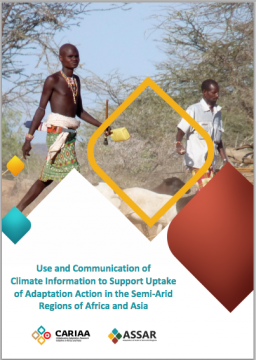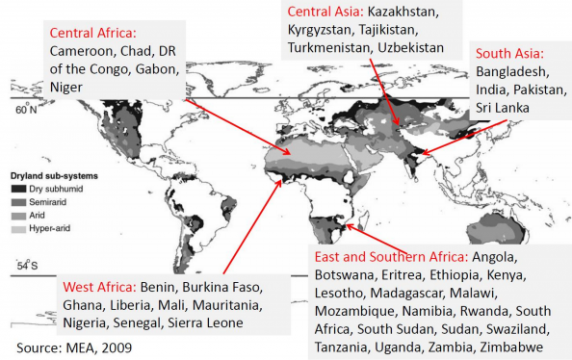Use and Communication of Climate Information to Support Uptake of Adaptation Action in the Semi-Arid Regions of Africa and Asia: ASSAR report


Home to hundreds of millions of people, the semi-arid regions of Africa and Asia are particularly vulnerable to climate-related impacts and risks. Working in 11 countries in these regions, ASSAR is a research project that seeks to understand the factors that have prevented climate change adaptation from being more widespread and successful. This article features ASSAR’s communication work.
Introduction
Africa and Asia are among the continents most vulnerable to the impacts of climate change. This vulnerability is further worsened by the poor state of their socio-economic development and low adaptive capacity. Hence the states within these two continents face a serious challenge in providing sustainable livelihoods for their populations, especially in the vulnerable and fragile ecosystems of their respective semi-arid regions. There is therefore a critical need for the development of adaptation policies, strategies and plans in response to the changing climate. To develop effective adapation policies, strategies and action plans, however, it is necessary to have a comprehensive and multi-sectoral understanding, communication and use of weather and climate information. The Collaborative Adaptation Research Initiative in Africa and Asia (CARIAA) aims to build the resilience of vulnerable populations and their livelihoods in semi-arid regions of Africa and Asia by supporting collaborative research to inform adaptation policies and practices. To realize this research goal, CARIAA has developed the Adaptation at Scale in Semi-Arid Regions (ASSAR). One of the research activities funded within this program is research on the factors that shape understanding and use of weather and climate information as well as challenges to and opportunities for effective communication of climate information in semi-arid regions of Asia and Africa. This research is structured in three overlapping but complementary phases: (1) Regional Diagnostic Study phase (RDS); (2) The Regional Research Program (RRP), and (3) Transformative Scenario Planning (TSP) and Knowledge Synthesis and Sharing phase.
This paper reports on the findings of the first phase of the research. This phase involved a desk study to examine how weather and climate information is understood, communicated and used in semiarid regions of Africa and Asia and the challenges and opportunities that could support effective communication and use of weather and climate information in semi-arid regions of Africa and Asia. Specifically, this diagnostic study phase addressed the following questions, to inform the next phase of the resarch:
1. What factors shape understanding and use of weather and climate information in semiarid regions of Africa and Asia? 2. How is weather and climate information communicated and used in semi-arid regions of Africa and Asia? 3. What challenges and opportunities could support effective communication and use of weather and climate information in semi-arid regions of Africa and Asia?

Semi-Arid areas of Africa and Asia
Key messages
The study found that understanding and use of weather and climate information in semi-arid regions of Africa and Asia is influenced by both intrinsic and contextual factors. The intrinsic factors that influence weather and climate information understanding and use include the communication channels, forms, and formats used to communicated the information. Contextual factors include community’s cultural practices and religious beliefs; community’s indigenous knowledge; community’s social structures and networks; locality i.e. rural versus urban settings; community livelihood practices and experiences; and gender. Although both intsrinsic and contextual factors influence understanding and use of weather and climate information, the study noted there is little research that examined exactly how these factors enable or hinder adoption of adaptations actions. 8 In this regard, the study has identified several research questions that could be explored in the next phase.
The study also identified several challenges and opportunities that could support effective communication and use of climate information. In particular, the study found that models that facilitate co-production of weather and climate information enable better understanding and use of climate information by different users. The study also noted that the combination of both people centred and technology-centered communication approaches enable better understanding and use of the communicated climate information. However, the study noted that while weather and climate information co-production models facilitate better understanding and use of information, how this information co-production is governed has not been addressed in the current literature. Yet, addressing governance aspects of weather and climate co-generation and communication could help address the trust issues that were also found to hinder use of climate information. The study has therefore raised research questions on governance aspects of climate information generation and communication that could be explored in the next phase.
More resources
- Click to see the main weADAPT ASSAR page.
- ASSAR on University of Cape Town’s website.
- See report on: Understanding information needs and barriers to adaptation – from practitioners perspectives.
(0) Comments
There is no content